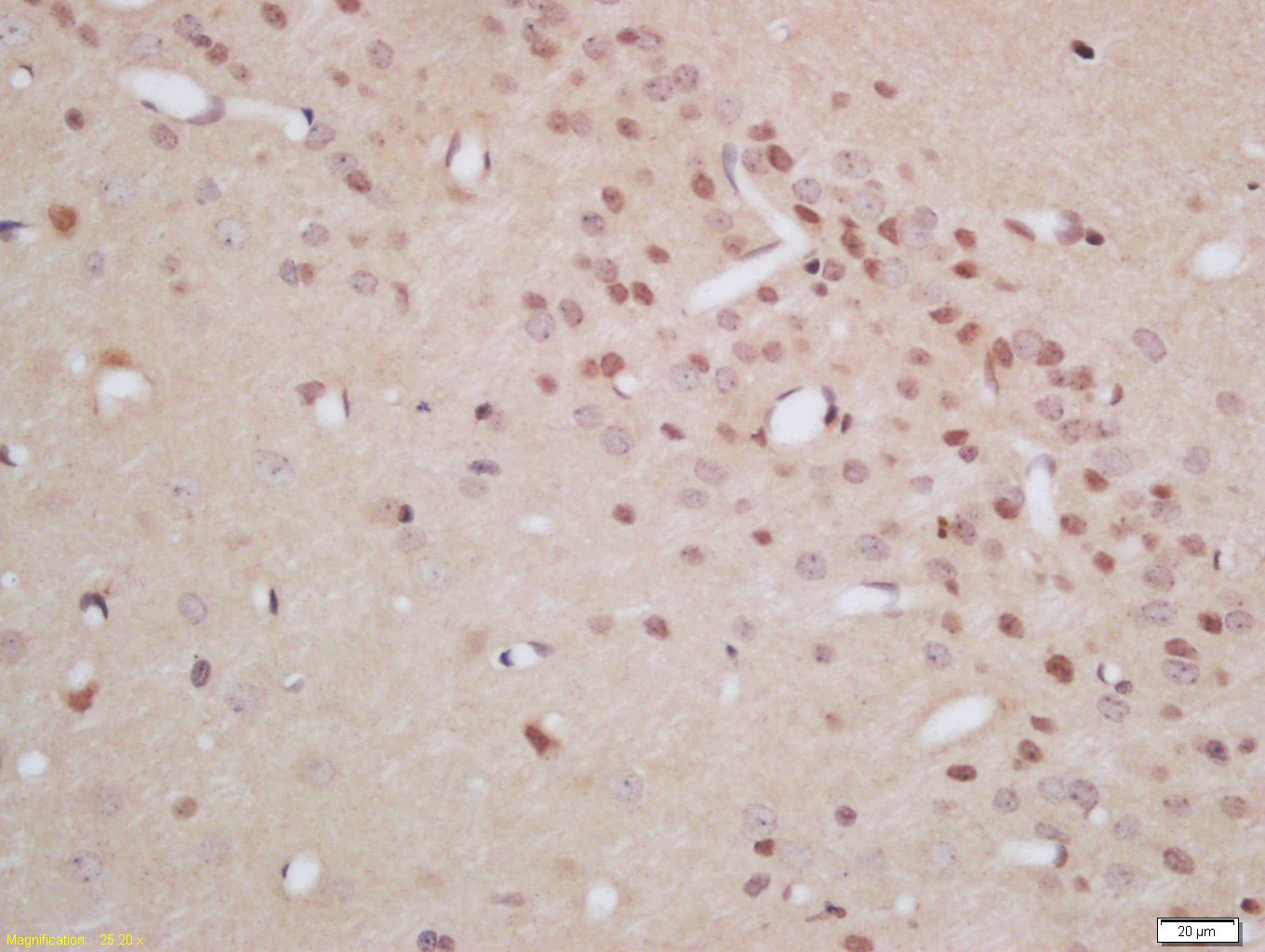CRBN Rabbit pAb
CRBN Rabbit pAb
- 产品详情
- 实验流程
- 背景知识
Application
| IHC-P, IHC-F, IF |
|---|---|
| Primary Accession | Q96SW2 |
| Reactivity | Mouse, Rat |
| Predicted | Human, Dog, Pig, Horse, Rabbit, Zebrafish, Sheep |
| Host | Rabbit |
| Clonality | Polyclonal |
| Calculated MW | 50546 Da |
| Physical State | Liquid |
| Immunogen | KLH conjugated synthetic peptide derived from human CRBN |
| Epitope Specificity | 210-288/442 |
| Isotype | IgG |
| Purity | affinity purified by Protein A |
| Buffer | 0.01M TBS (pH7.4) with 1% BSA, 0.02% Proclin300 and 50% Glycerol. |
| SUBCELLULAR LOCATION | Cytoplasm. Nucleus. Membrane; Peripheral membrane protein |
| SIMILARITY | Belongs to the CRBN family. |
| SUBUNIT | Interacts with KCNT1 (By similarity). Component of a DCX (DDB1-CUL4-X-box) protein ligase complex, at least composed of CRBN, CUL4A, DDB1 and RBX1. |
| Post-translational modifications | Ubiquitinated, ubiquitination is mediated by its own DCX protein ligase complex. |
| DISEASE | Defects in CRBN are the cause of mental retardation autosomal recessive type 2A (MRT2A) [MIM:607417]. MRT2A patients display mild mental retardation with a standard IQ ranged from 50 to 70. IQ scores are lower in males than females. Developmental milestones are mildly delayed. There are no dysmorphic or autistic features. Non-syndromic mental retardation patients do not manifest other clinical signs. |
| Important Note | This product as supplied is intended for research use only, not for use in human, therapeutic or diagnostic applications. |
| Background Descriptions | CRBN is a 442 amino acid protein which is highly concentrated in human brain tissue. CRBN functions are thought to be related to energy metabolism, learning and memory. Localized to the cytoplasm, CRBN acts as a protease in mitochondria and is thought to regulate the assembly of KCNT1, as well as the surface expression of KCNT1 in brain regions known to affect memory and learning, such as the hippocampus. The gene encoding CRBN belongs to a family of ATP-dependent lon proteases that play a role in membrane trafficking and proteolysis. Defects in the CRBN gene are associated with mild mental retardation. |
| Gene ID | 51185 |
|---|---|
| Other Names | Protein cereblon, CRBN |
| Target/Specificity | Widely expressed. Highly expressed in brain. |
| Dilution | IHC-P=1:100-500,IHC-F=1:100-500,IF=1:100-500 |
| Storage | Store at -20 °C for one year. Avoid repeated freeze/thaw cycles. When reconstituted in sterile pH 7.4 0.01M PBS or diluent of antibody the antibody is stable for at least two weeks at 2-4 °C. |
| Name | CRBN |
|---|---|
| Function | Substrate recognition component of a DCX (DDB1-CUL4-X-box) E3 protein ligase complex that mediates the ubiquitination and subsequent proteasomal degradation of target proteins, such as MEIS2, ILF2 or GLUL (PubMed:26990986, PubMed:33009960). Normal degradation of key regulatory proteins is required for normal limb outgrowth and expression of the fibroblast growth factor FGF8 (PubMed:20223979, PubMed:24328678, PubMed:25043012, PubMed:25108355). Maintains presynaptic glutamate release and consequently cognitive functions, such as memory and learning, by negatively regulating large-conductance calcium-activated potassium (BK) channels in excitatory neurons (PubMed:18414909, PubMed:29530986). Likely to function by regulating the assembly and neuronal surface expression of BK channels via its interaction with KCNT1 (PubMed:18414909). May also be involved in regulating anxiety-like behaviors via a BK channel-independent mechanism (By similarity). Plays a negative role in TLR4 signaling by interacting with TRAF6 and ECSIT, leading to inhibition of ECSIT ubiquitination, an important step of the signaling (PubMed:31620128). |
| Cellular Location | Cytoplasm. Nucleus. Membrane; Peripheral membrane protein |
| Tissue Location | Widely expressed. Highly expressed in brain. |
For Research Use Only. Not For Use In Diagnostic Procedures.
Provided below are standard protocols that you may find useful for product applications.
BACKGROUND
CRBN is a 442 amino acid protein which is highly concentrated in human brain tissue. CRBN functions are thought to be related to energy metabolism, learning and memory. Localized to the cytoplasm, CRBN acts as a protease in mitochondria and is thought to regulate the assembly of KCNT1, as well as the surface expression of KCNT1 in brain regions known to affect memory and learning, such as the hippocampus. The gene encoding CRBN belongs to a family of ATP-dependent lon proteases that play a role in membrane trafficking and proteolysis. Defects in the CRBN gene are associated with mild mental retardation.
终于等到您。ABCEPTA(百远生物)抗体产品。
点击下方“我要评价 ”按钮提交您的反馈信息,您的反馈和评价是我们最宝贵的财富之一,
我们将在1-3个工作日内处理您的反馈信息。
如有疑问,联系:0512-88856768 tech-china@abcepta.com.























 癌症的基本特征包括细胞增殖、血管生成、迁移、凋亡逃避机制和细胞永生等。找到癌症发生过程中这些通路的关键标记物和对应的抗体用于检测至关重要。
癌症的基本特征包括细胞增殖、血管生成、迁移、凋亡逃避机制和细胞永生等。找到癌症发生过程中这些通路的关键标记物和对应的抗体用于检测至关重要。 为您推荐一个泛素化位点预测神器——泛素化分析工具,可以为您的蛋白的泛素化位点作出预测和评分。
为您推荐一个泛素化位点预测神器——泛素化分析工具,可以为您的蛋白的泛素化位点作出预测和评分。 细胞自噬受体图形绘图工具为你的蛋白的细胞受体结合位点作出预测和评分,识别结合到自噬通路中的蛋白是非常重要的,便于让我们理解自噬在正常生理、病理过程中的作用,如发育、细胞分化、神经退化性疾病、压力条件下、感染和癌症。
细胞自噬受体图形绘图工具为你的蛋白的细胞受体结合位点作出预测和评分,识别结合到自噬通路中的蛋白是非常重要的,便于让我们理解自噬在正常生理、病理过程中的作用,如发育、细胞分化、神经退化性疾病、压力条件下、感染和癌症。






